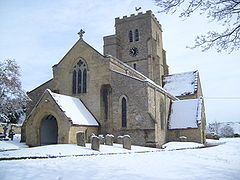- Cuddesdon
-
Coordinates: 51°43′23″N 1°07′59″W / 51.723°N 1.133°W
Cuddesdon 
All Saints' parish church
 Cuddesdon shown within Oxfordshire
Cuddesdon shown within OxfordshirePopulation 502 (parish, including Denton) (2001 census)[1] OS grid reference SP6003 Parish Cuddesdon and Denton District South Oxfordshire Shire county Oxfordshire Region South East Country England Sovereign state United Kingdom Post town Oxford Postcode district OX44 Dialling code 01865 Police Thames Valley Fire Oxfordshire Ambulance South Central EU Parliament South East England UK Parliament Henley Website Cuddesdon and Denton Community Website List of places: UK • England • Oxfordshire Cuddesdon is an east Oxfordshire village (within the administrative district of South Oxfordshire) about 5.5 miles (8.9 km) east of Oxford. It is notable as the location of Ripon College Cuddesdon.
The parish population includes about 430 in Cuddesdon and about 70 in the hamlets of Denton and Chippinghurst (2001 census).
Contents
History
Cuddesdon's toponym is derived from the Old English Cuddes Dune meaning "Cudde's Hill" or the "Hill of Cuthwine". When Oxfordshire was administered in hundreds, Cuddesdon parish was in the hundred of Bullingdon.
Cuddesdon was an Anglo-Saxon linear village along what is now High Street, but since the 19th century Church of England additions on the northern edge of the village and 20th century residential developments (principally Bishop's Wood and Parkside), it has become a nuclear settlement centred on The Green.
Since the 1950s many facilities and businesses in Cuddesdon, as in similar English villages, have closed and mostly been converted into housing for an increasingly commuter population. These include the petrol station, the shop, the school, the mill, the second public house and various farm buildings. Thus the village has turned from a compact community into what is largely a dormitory village.
Site
The parish is bounded by the River Thame to the east and southeast, its tributary Cuddesdon Brook to the north, by the road between Wheatley and Garsington to the west and by field boundaries to the southwest. The village is on a hill that overlooks south Oxfordshire, northern Berkshire, the Aylesbury Vale in central Buckinghamshire and a small part of west Bedfordshire.[citation needed] There are views of both the Chiltern Hills and the North Wessex Downs AONB stretching from Ivinghoe Beacon in the east to Didcot Power Station in the west.
The village today
There is a free monthly parish newsletter and a reasonably active social life in the village, with annual Guy Fawkes Night fireworks, a village fête and various groups that meet regularly such as the film club. Most social activities are organised or co-ordinated by the Parish Council or its subsidiaries.
The Church of England parish church of All Saints, the Bat and Ball inn, the Village Hall, Ripon College Cuddesdon and the farms are all still active. There has also been much talk of reopening a village shop, but a solution is as yet unforthcoming.
In November 2007 a public consultation was held on the proposed Parish Plan - a strategic document that promises to chart the hopes of the village for twenty years to come.
Ecclesiastical presence
Parish church
Abingdon Abbey founded the Church of England parish church of All Saints in Cuddesdon in about AD 1180.[2] All Saints' parish belongs to the Aston and Cuddesdon Deanery of the Diocese of Oxford.
Bishop's Palace
Cuddesdon Palace was completed by 1634 for John Bancroft, who was Bishop of Oxford from 1632 until 1641.[3] In 1644 during the English Civil War Royalist forces burned the palace to render it unusable by the Parliamentarian forces besieging Oxford.[3] In 1676 John Fell was made Bishop of Oxford and in 1679 he commissioned the complete rebuilding of the palace.[3] In 1846 Bishop Samuel Wilberforce had the chapel of Saints Peter and Paul added to the Palace.[3] It was designed by the Gothic Revival architect Benjamin Ferrey.[3]
Successive Bishops of Oxford resided at the palace until Thomas Banks Strong retired in 1937.[3] For the duration of the Second World War Queen Anne's Bounty was evacuated from London and occupied the palace.[3] Thereafter, The Society of the Salutation of Mary the Virgin occupied the palace from 1946 until 1949.[3] In the 1960s the palace was in private use for a few years, but it burnt down before the end of that decade. The bishop's chapel escaped the fire and survives today.[4]
Theological college
In 1854 Bishop Wilberforce founded Cuddesdon College on land opposite the Palace to train men to become Anglican clergy. In 1975 the college merged with Ripon Hall to form Ripon College Cuddesdon.
Due to the extent of past and present church connections, the village is also known as the "Holy Hill". It has been suggested that in Cuddesdon "the presence of the Church has been more strongly felt than perhaps anywhere else in England".[5]
Baron Cuddesdon
After his retirement in 1991, Robert Runcie, former Archbishop of Canterbury and also a former vicar of Cuddesdon and college principal, took the title Baron Runcie of Cuddesdon.
References
- ^ "Area: Cuddesdon and Denton CP (Parish): Parish Headcounts". Neighbourhood Statistics. Office for National Statistics. http://neighbourhood.statistics.gov.uk/dissemination/LeadTableView.do?a=7&b=798639&c=Cuddesdon&d=16&e=15&g=480899&i=1001x1003x1004&o=1&m=0&r=1&s=1268755335703&enc=1&dsFamilyId=779. Retrieved 16 March 2010.
- ^ Sherwood & Pevsner, 1974, page 562
- ^ a b c d e f g h Lobel, 1957, pages 96-116
- ^ Sherwood & Pevsner, 1974, page 563.
- ^ Chapman, 2004, page not cited.
Sources
- Chapman, Mark (2004). God's Holy Hill: A History of Christianity in Cuddesdon. Chipping Norton: The Wychwood Press. ISBN 1902279204.
- Lobel, Mary D, ed (1957). A History of the County of Oxford: Volume 5: Bullingdon Hundred. Victoria County History. pp. 96–116.
- Sherwood, Jennifer; Pevsner, Nikolaus (1974). Oxfordshire. The Buildings of England. Harmondsworth: Penguin Books. pp. 562–565. ISBN 0 14 071045 0.
External links
 Media related to Cuddesdon at Wikimedia CommonsCategories:
Media related to Cuddesdon at Wikimedia CommonsCategories:- Villages in Oxfordshire
- South Oxfordshire
Wikimedia Foundation. 2010.




